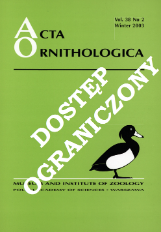- Tytuł:
-
The breeding ecology of the greenfinch Carduelis chloris in urban conditions (study in Krotoszyn, W Poland)
Acta Ornithologica, vol. 36, no. 2
Breeding ecology of urban greenfinch
Ekologia lęgowa dzwońca w warunkach miejskich na przykładzie Krotoszyna - Autorzy:
- Kosiński, Ziemowit
- Współwytwórcy:
- Polska Akademia Nauk. Muzeum i Instytut Zoologii
- Data publikacji:
- 2001
- Wydawca:
- Muzeum i Instytut Zoologii PAN
- Słowa kluczowe:
-
Krotoszyn
nest sites
nesting success
finches
Fringillidae
breeding success
Carduelis chloris
Greenfinch
clutch size
timing of breeding
łuszczaki
Dzwoniec -- biologia lęgowa -- Polska -- Krotoszyn (województwo wielkopolskie) [KABA]
ptaki
birds
Aves
Poland
ekologia rozrodu
ptaki miast
breeding biology - Źródło:
-
MiIZ PAN, patrz sygn. czas. P.4568, Vol. 36, No 2
MiIZ PAN, call no. P.257, Vol. 36, No 2
http://katalog.pan.pl/webpac-bin/228bmiizPL/wgbroker.exe?new+-access+top+search+open+NR+xx002753944
http://katalog.pan.pl/webpac-bin/228bmiizEN/wgbroker.exe?new+-access+top+search+open+NR+xx002753944
MiIZ PAN, call no. P.4568, Vol. 36, No 2
MiIZ PAN, patrz sygn. czas. P.257, Vol. 36, No 2 - Język:
-
polski
angielski - Prawa:
-
Prawa zastrzeżone - dostęp ograniczony
Rights Reserved - Restricted Access - Linki:
- https://rcin.org.pl/dlibra/publication/edition/45294/content Link otwiera się w nowym oknie
- Dostawca treści:
- RCIN - Repozytorium Cyfrowe Instytutów Naukowych
- Książka
Menu główne
Wyszukiwarka
Treść główna

